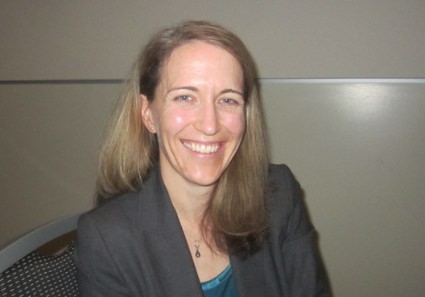User login
VANCOUVER, B.C. – A proactive, collaborative care approach is best for teenage depression, according to Dr. Laura P. Richardson.
She and her team randomized 51 adolescents aged 13-17 years old who had screened positive for depression on the Patient Health Questionnaire 9 and other measures to standard care, and 50 others to a collaborative model overseen by a master’s level depression care manager.
Both groups had a mean baseline score of about 47 on the Children’s Depression Rating Scale (CDRS), but soon separated. At 6 months, 50% of the treatment group, but only 15% of the control group, had a drop of at least 50% in their CDRS score; at 1 year, the difference had grown to 70%, vs. 30%. With the majority of adolescents in each arm still involved in the project, the mean 12-month CDRS score in the collaborative care group was 26, vs. about 35 for the control group. Also at 12 months, the treatment group’s mean score on the Columbia Impairment Scale was 13.2, vs. 17.1 in the control arm. The differences were all statistically significant.
The adolescents in the collaborative arm ended up having more therapy sessions and medication, as well, and reported greater satisfaction with their care.
Often in the United States, when adolescents feeling down see their primary care physician, they walk out of the office with a list of psychotherapists to contact and maybe a short course of antidepressants, after being told to come back in a month. "They often don’t, because they aren’t doing well and aren’t motivated," said lead investigator Dr. Richardson, a specialist in adolescent medicine at Seattle Children’s Hospital.
Instead, the care manager worked with the adolescents and their parents to pick antidepressants, regular cognitive-behavioral therapy sessions, or both. The manager then checked in with them about every week and tracked how the adolescents did in a disease registry. Those who needed more help got it.
As is often the case, the usual care kids were simply encouraged to seek care for depression, Dr. Richardson noted.
The results show that "we can do better" when it comes to depressed teens. "Patient engagement and tracking are critical. Unless we engage youth up front and keep them engaged, we are probably not going to make a difference. A lot of it [comes down to] training people to be proactive, because we haven’t been," she said at the Pediatric Academic Societies annual meeting.
With just a year’s data, it’s unknown if the extra up-front costs save money down the road, though that’s been shown in adults. The model is being tried elsewhere in the country.
The mean age in the study was about 15 years, and about three-quarters of the participants were girls. Most of the adolescents were white.
The investigators excluded adolescents who were already seeing a psychiatrist; those who had developmental delays or previous mental health hospitalizations; and those who had bipolar disorder, were abusing drugs, or were unable to speak English.
Dr. Richardson said she had no relevant financial disclosures. The work was funded by the National Institute of Mental Health.
VANCOUVER, B.C. – A proactive, collaborative care approach is best for teenage depression, according to Dr. Laura P. Richardson.
She and her team randomized 51 adolescents aged 13-17 years old who had screened positive for depression on the Patient Health Questionnaire 9 and other measures to standard care, and 50 others to a collaborative model overseen by a master’s level depression care manager.
Both groups had a mean baseline score of about 47 on the Children’s Depression Rating Scale (CDRS), but soon separated. At 6 months, 50% of the treatment group, but only 15% of the control group, had a drop of at least 50% in their CDRS score; at 1 year, the difference had grown to 70%, vs. 30%. With the majority of adolescents in each arm still involved in the project, the mean 12-month CDRS score in the collaborative care group was 26, vs. about 35 for the control group. Also at 12 months, the treatment group’s mean score on the Columbia Impairment Scale was 13.2, vs. 17.1 in the control arm. The differences were all statistically significant.
The adolescents in the collaborative arm ended up having more therapy sessions and medication, as well, and reported greater satisfaction with their care.
Often in the United States, when adolescents feeling down see their primary care physician, they walk out of the office with a list of psychotherapists to contact and maybe a short course of antidepressants, after being told to come back in a month. "They often don’t, because they aren’t doing well and aren’t motivated," said lead investigator Dr. Richardson, a specialist in adolescent medicine at Seattle Children’s Hospital.
Instead, the care manager worked with the adolescents and their parents to pick antidepressants, regular cognitive-behavioral therapy sessions, or both. The manager then checked in with them about every week and tracked how the adolescents did in a disease registry. Those who needed more help got it.
As is often the case, the usual care kids were simply encouraged to seek care for depression, Dr. Richardson noted.
The results show that "we can do better" when it comes to depressed teens. "Patient engagement and tracking are critical. Unless we engage youth up front and keep them engaged, we are probably not going to make a difference. A lot of it [comes down to] training people to be proactive, because we haven’t been," she said at the Pediatric Academic Societies annual meeting.
With just a year’s data, it’s unknown if the extra up-front costs save money down the road, though that’s been shown in adults. The model is being tried elsewhere in the country.
The mean age in the study was about 15 years, and about three-quarters of the participants were girls. Most of the adolescents were white.
The investigators excluded adolescents who were already seeing a psychiatrist; those who had developmental delays or previous mental health hospitalizations; and those who had bipolar disorder, were abusing drugs, or were unable to speak English.
Dr. Richardson said she had no relevant financial disclosures. The work was funded by the National Institute of Mental Health.
VANCOUVER, B.C. – A proactive, collaborative care approach is best for teenage depression, according to Dr. Laura P. Richardson.
She and her team randomized 51 adolescents aged 13-17 years old who had screened positive for depression on the Patient Health Questionnaire 9 and other measures to standard care, and 50 others to a collaborative model overseen by a master’s level depression care manager.
Both groups had a mean baseline score of about 47 on the Children’s Depression Rating Scale (CDRS), but soon separated. At 6 months, 50% of the treatment group, but only 15% of the control group, had a drop of at least 50% in their CDRS score; at 1 year, the difference had grown to 70%, vs. 30%. With the majority of adolescents in each arm still involved in the project, the mean 12-month CDRS score in the collaborative care group was 26, vs. about 35 for the control group. Also at 12 months, the treatment group’s mean score on the Columbia Impairment Scale was 13.2, vs. 17.1 in the control arm. The differences were all statistically significant.
The adolescents in the collaborative arm ended up having more therapy sessions and medication, as well, and reported greater satisfaction with their care.
Often in the United States, when adolescents feeling down see their primary care physician, they walk out of the office with a list of psychotherapists to contact and maybe a short course of antidepressants, after being told to come back in a month. "They often don’t, because they aren’t doing well and aren’t motivated," said lead investigator Dr. Richardson, a specialist in adolescent medicine at Seattle Children’s Hospital.
Instead, the care manager worked with the adolescents and their parents to pick antidepressants, regular cognitive-behavioral therapy sessions, or both. The manager then checked in with them about every week and tracked how the adolescents did in a disease registry. Those who needed more help got it.
As is often the case, the usual care kids were simply encouraged to seek care for depression, Dr. Richardson noted.
The results show that "we can do better" when it comes to depressed teens. "Patient engagement and tracking are critical. Unless we engage youth up front and keep them engaged, we are probably not going to make a difference. A lot of it [comes down to] training people to be proactive, because we haven’t been," she said at the Pediatric Academic Societies annual meeting.
With just a year’s data, it’s unknown if the extra up-front costs save money down the road, though that’s been shown in adults. The model is being tried elsewhere in the country.
The mean age in the study was about 15 years, and about three-quarters of the participants were girls. Most of the adolescents were white.
The investigators excluded adolescents who were already seeing a psychiatrist; those who had developmental delays or previous mental health hospitalizations; and those who had bipolar disorder, were abusing drugs, or were unable to speak English.
Dr. Richardson said she had no relevant financial disclosures. The work was funded by the National Institute of Mental Health.
AT THE PAS ANNUAL MEETING
Key clinical point: Outcomes are better – and, ultimately, costs are probably lower – when a master’s level manager oversees the treatment of depressed teens.
Major finding: After 6 months, 50% of the depressed teens assigned to collaborative care, but just 15% of those assigned to usual care had a drop of at least 50% in their Child Depression Rating Scale score, a significant difference.
Data source: A randomized trial of 101 depressed teenagers.
Disclosures: Dr. Richardson said she had no relevant financial disclosures. The work was funded by the National Institute of Mental Health.

